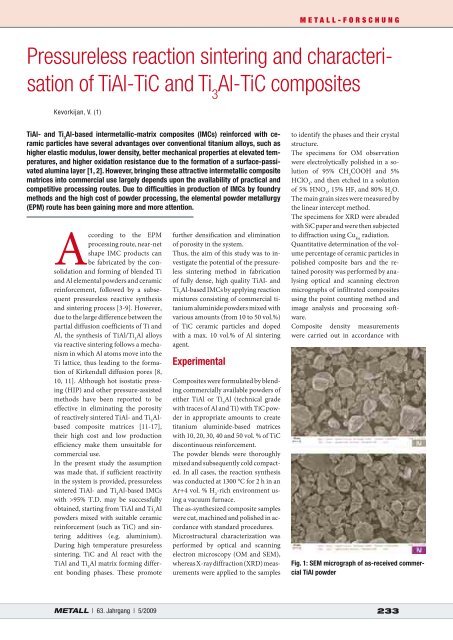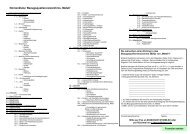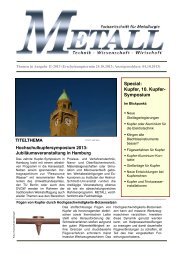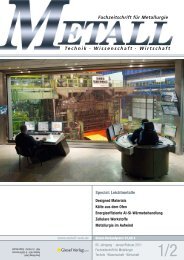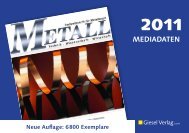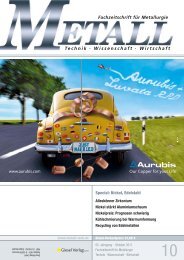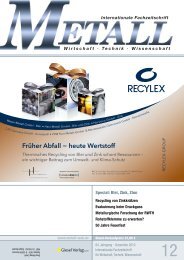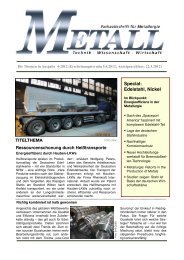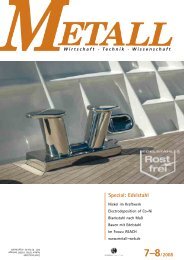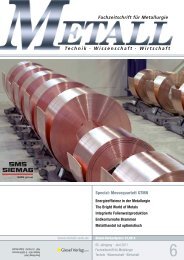Verlassen Sie sich darauf: Geballte Metall-Kompetenz - Metall-web.de
Verlassen Sie sich darauf: Geballte Metall-Kompetenz - Metall-web.de
Verlassen Sie sich darauf: Geballte Metall-Kompetenz - Metall-web.de
Sie wollen auch ein ePaper? Erhöhen Sie die Reichweite Ihrer Titel.
YUMPU macht aus Druck-PDFs automatisch weboptimierte ePaper, die Google liebt.
METALL | 63. Jahrgang | 5/2009<br />
METALL-FORSCHUNG<br />
Pressureless reaction sintering and characte risation<br />
of TiAl-TiC and Ti 3 Al-TiC composites<br />
Kevorkijan, V. (1)<br />
TiAl- and Ti 3 Al-based intermetallic-matrix composites (IMCs) reinforced with ceramic<br />
particles have several advantages over conventional titanium alloys, such as<br />
higher elastic modulus, lower <strong>de</strong>nsity, better mechanical properties at elevated temperatures,<br />
and higher oxidation resistance due to the formation of a surface-passivated<br />
alumina layer [1, 2]. However, bringing these attractive intermetallic composite<br />
matrices into commercial use largely <strong>de</strong>pends upon the availability of practical and<br />
competitive processing routes. Due to diffi culties in production of IMCs by foundry<br />
methods and the high cost of pow<strong>de</strong>r processing, the elemental pow<strong>de</strong>r metallurgy<br />
(EPM) route has been gaining more and more attention.<br />
According to the EPM<br />
processing route, near-net<br />
shape IMC products can<br />
be fabricated by the consolidation<br />
and forming of blen<strong>de</strong>d Ti<br />
and Al elemental pow<strong>de</strong>rs and ceramic<br />
reinforcement, followed by a subsequent<br />
pressureless reactive synthesis<br />
and sintering process [3-9]. However,<br />
due to the large difference between the<br />
partial diffusion coefficients of Ti and<br />
Al, the synthesis of TiAl/Ti 3 Al alloys<br />
via reactive sintering follows a mechanism<br />
in which Al atoms move into the<br />
Ti lattice, thus leading to the formation<br />
of Kirkendall diffusion pores [8,<br />
10, 11]. Although hot isostatic pressing<br />
(HIP) and other pressure-assisted<br />
methods have been reported to be<br />
effective in eliminating the porosity<br />
of reactively sintered TiAl- and Ti 3 Albased<br />
composite matrices [11-17],<br />
their high cost and low production<br />
efficiency make them unsuitable for<br />
commercial use.<br />
In the present study the assumption<br />
was ma<strong>de</strong> that, if sufficient reactivity<br />
in the system is provi<strong>de</strong>d, pressureless<br />
sintered TiAl- and Ti 3 Al-based IMCs<br />
with >95% T.D. may be successfully<br />
obtained, starting from TiAl and Ti 3 Al<br />
pow<strong>de</strong>rs mixed with suitable ceramic<br />
reinforcement (such as TiC) and sintering<br />
additives (e.g. aluminium).<br />
During high temperature presureless<br />
sintering, TiC and Al react with the<br />
TiAl and Ti 3 Al matrix forming different<br />
bonding phases. These promote<br />
further <strong>de</strong>nsification and elimination<br />
of porosity in the system.<br />
Thus, the aim of this study was to investigate<br />
the potential of the pressureless<br />
sintering method in fabrication<br />
of fully <strong>de</strong>nse, high quality TiAl- and<br />
Ti 3 Al-based IMCs by applying reaction<br />
mixtures consisting of commercial titanium<br />
alumini<strong>de</strong> pow<strong>de</strong>rs mixed with<br />
various amounts (from 10 to 50 vol.%)<br />
of TiC ceramic particles and doped<br />
with a max. 10 vol.% of Al sintering<br />
agent.<br />
Experimental<br />
Composites were formulated by blending<br />
commercially available pow<strong>de</strong>rs of<br />
either TiAl or Ti 3 Al (technical gra<strong>de</strong><br />
with traces of Al and Ti) with TiC pow<strong>de</strong>r<br />
in appropriate amounts to create<br />
titanium alumini<strong>de</strong>-based matrices<br />
with 10, 20, 30, 40 and 50 vol. % of TiC<br />
discontinuous reinforcement.<br />
The pow<strong>de</strong>r blends were thoroughly<br />
mixed and subsequently cold compacted.<br />
In all cases, the reaction synthesis<br />
was conducted at 1300 °C for 2 h in an<br />
Ar+4 vol. % H 2 -rich environment using<br />
a vacuum furnace.<br />
The as-synthesized composite samples<br />
were cut, machined and polished in accordance<br />
with standard procedures.<br />
Microstructural characterization was<br />
performed by optical and scanning<br />
electron microscopy (OM and SEM),<br />
whereas X-ray diffraction (XRD) measurements<br />
were applied to the samples<br />
to i<strong>de</strong>ntify the phases and their crystal<br />
structure.<br />
The specimens for OM observation<br />
were electrolytically polished in a solution<br />
of 95% CH 3 COOH and 5%<br />
HClO 4 , and then etched in a solution<br />
of 5% HNO 3 , 15% HF, and 80% H 2 O.<br />
The main grain sizes were measured by<br />
the linear intercept method.<br />
The specimens for XRD were abra<strong>de</strong>d<br />
with SiC paper and were then subjected<br />
to diffraction using Cu Kα radiation.<br />
Quantitative <strong>de</strong>termination of the volume<br />
percentage of ceramic particles in<br />
polished composite bars and the retained<br />
porosity was performed by analysing<br />
optical and scanning electron<br />
micrographs of infiltrated composites<br />
using the point counting method and<br />
image analysis and processing software.<br />
Composite <strong>de</strong>nsity measurements<br />
were carried out in accordance with<br />
Fig. 1: SEM micrograph of as-received commercial<br />
TiAl pow<strong>de</strong>r<br />
233


